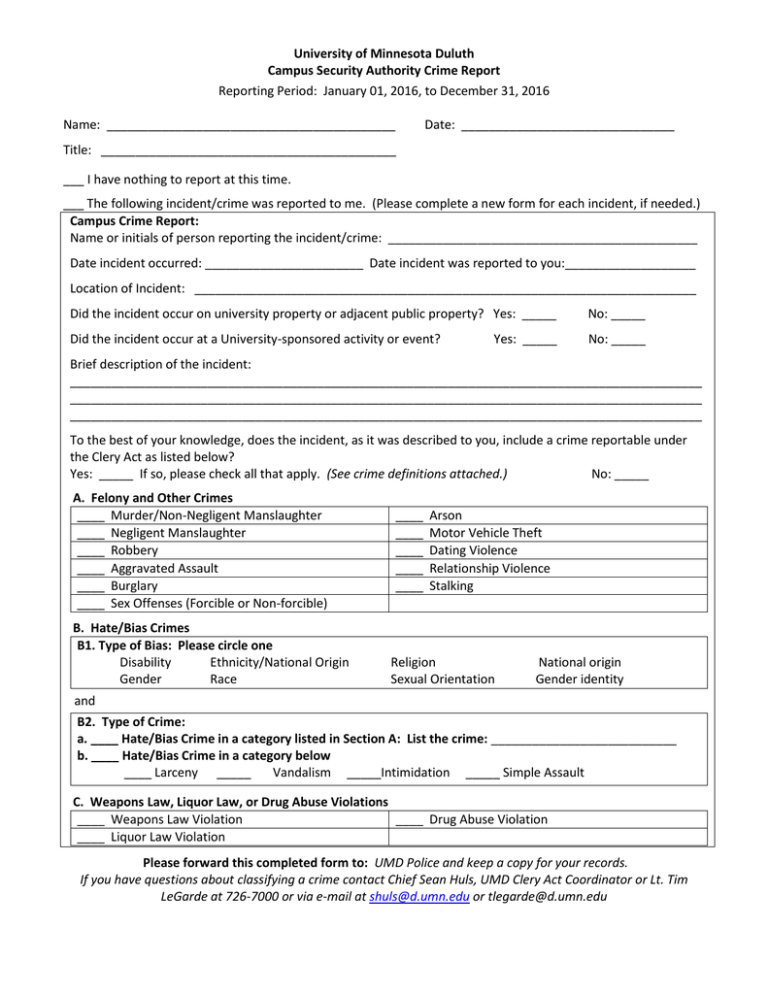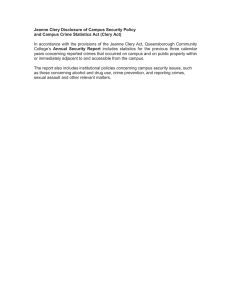
University of Minnesota Duluth
Campus Security Authority Crime Report
Reporting Period: January 01, 2016, to December 31, 2016
Name: __________________________________________
Date: _______________________________
Title: ___________________________________________
___ I have nothing to report at this time.
___ The following incident/crime was reported to me. (Please complete a new form for each incident, if needed.)
Campus Crime Report:
Name or initials of person reporting the incident/crime: _____________________________________________
Date incident occurred: _______________________ Date incident was reported to you:___________________
Location of Incident: _________________________________________________________________________
Did the incident occur on university property or adjacent public property? Yes: _____
No: _____
Did the incident occur at a University-sponsored activity or event?
No: _____
Yes: _____
Brief description of the incident:
____________________________________________________________________________________________
____________________________________________________________________________________________
____________________________________________________________________________________________
To the best of your knowledge, does the incident, as it was described to you, include a crime reportable under
the Clery Act as listed below?
Yes: _____ If so, please check all that apply. (See crime definitions attached.)
No: _____
A. Felony and Other Crimes
____ Murder/Non-Negligent Manslaughter
____ Negligent Manslaughter
____ Robbery
____ Aggravated Assault
____ Burglary
____ Sex Offenses (Forcible or Non-forcible)
B. Hate/Bias Crimes
B1. Type of Bias: Please circle one
Disability
Ethnicity/National Origin
Gender
Race
____
____
____
____
____
Arson
Motor Vehicle Theft
Dating Violence
Relationship Violence
Stalking
Religion
Sexual Orientation
National origin
Gender identity
and
B2. Type of Crime:
a. ____ Hate/Bias Crime in a category listed in Section A: List the crime: ___________________________
b. ____ Hate/Bias Crime in a category below
____ Larceny _____
Vandalism _____Intimidation _____ Simple Assault
C. Weapons Law, Liquor Law, or Drug Abuse Violations
____ Weapons Law Violation
____ Drug Abuse Violation
____ Liquor Law Violation
Please forward this completed form to: UMD Police and keep a copy for your records.
If you have questions about classifying a crime contact Chief Sean Huls, UMD Clery Act Coordinator or Lt. Tim
LeGarde at 726-7000 or via e-mail at shuls@d.umn.edu or tlegarde@d.umn.edu
University of Minnesota Duluth Campus Security Authorities
According to a federal law known as the Jeanne Clery Disclosure of Campus Security Policy and Campus Crime
Statistics Act, UMD and all universities receiving federal student financial aid funds are required to disclose
“statistics concerning the occurrence of certain criminal offenses reported to local law enforcement agencies or
any official of the institution who is defined as a ‘Campus Security Authority.’”
The law defines “Campus Security Authority” as “An official of an institution who has significant responsibility for
student and campus activities, including, but not limited to student housing, student discipline and campus
judicial proceedings.” Federal guidance notes that a dean of students, a director of athletics, a team coach, or a
faculty advisor to a student group also have significant responsibility for student and campus activities. A single
teaching faculty member is unlikely to have significant responsibility for student or campus activities except when
serving as an advisor to a student group or as students’ academic advisor. Clerical staff, as well, are unlikely to
have significant responsibility for student and campus activities as defined by the Clery Act.
Crimes may be reported to persons on campus who have been designated as having significant responsibility for
student and/or campus activities. Each will be responsible for forwarding campus crime reports to UMD Police for
investigation and campus crime reporting in compliance with the Campus Security Act.
Note: The 1998 amendments to the Clery Act note that Student Counseling staff are not required to report or
disclose privileged information as Campus Security Authorities. As a matter of policy, they are encouraged, if and
when they deem it appropriate, to inform persons being counseled of the procedures to report crimes on a
voluntary basis for inclusion into the annual crime statistics.
Definitions for Clery Act Reportable Crimes
A. Felony and Other Crimes
Murder/Non-Negligent Manslaughter: the willful (non-negligent) killing of one human being by another. NOTE:
Deaths caused by negligence, attempts to kill, assaults to kill, suicides, accidental deaths, and justifiable homicides
are excluded.
Negligent Manslaughter: the killing of another person through gross negligence.
Robbery: the taking or attempting to take anything from value of the care, custody or control of a person or
persons by force or threat of force or violence and/or by putting the victim in fear.
Aggravated Assault: an unlawful attack by one person upon another for the purpose of inflicting severe or
aggravated bodily injury. This type of assault usually is accompanied by the use of a weapon or by means likely to
produce death or great bodily harm. It is not necessary that injury result from an aggravated assault when a gun,
knife or other weapon is used which could or probably would result in a serious potential injury if the crime were
successfully completed.
Sex Offenses-Forcible: Any sexual act directed against another person, forcibly and/or against that person’s will;
or not forcibly or against the person’s will where the victim is incapable of giving consent.
A. Forcible Rape: The carnal knowledge of a person, forcibly and/or against the person’s will; or not forcibly
or against the person’s will where the victim is incapable of giving consent because of his/her temporary or
permanent mental or physical incapacity (or because of his/her youth).
B. Forcible Sodomy: Oral or anal sexual intercourse with another person, forcibly and/or against that
person’s will; or not forcibly against the person’s will where the victim is incapable of giving consent
because of his/her youth or because of his/her temporary or permanent mental or physical incapacity.
C. Sexual Assault With An Object: The use of an object or instrument to unlawfully penetrate, however
slightly, the genital or anal opening of the body of another person, forcibly and/or against that person’s will;
or not forcibly or against the person’s will where the victim is incapable of giving consent because of his/her
youth or because of his/her temporary or permanent mental or physical incapacity.
D. Forcible Fondling: The touching of the private body parts of another person for the purpose of sexual
gratification, forcibly and/or against that person’s will; or, not forcibly or against the person’s will where the
victim is incapable of giving consent because of his/her youth or because of his/her temporary or
permanent mental incapacity.
Sex Offenses-Non-forcible: Unlawful, non-forcible sexual intercourse.
A. Incest: Non-forcible sexual intercourse between persons who are related to each other within the
degrees wherein marriage is prohibited by law.
B. Statutory Rape: Non-forcible sexual intercourse with a person who is under the statutory age of consent.
Sex Offenses Definitions From the National Incident-Based Reporting System Edition of the Uniform Crime
Reporting Program
Burglary: The unlawful entry of a structure to commit a felony or a theft. For reporting purposes this definition
includes: unlawful entry with intent to commit a larceny or a felony; breaking and entering with intent to commit
a larceny; housebreaking; safecracking; and all attempts to commit any of the aforementioned.
Motor Vehicle Theft: The theft or attempted theft of a motor vehicle. (Classify as motor vehicle theft all cases
where automobiles are taken by persons not having lawful access, even though the vehicles are later abandoned including joy riding)
Arson: The willful or malicious burning or attempt to burn, with or without intent to defraud, a dwelling house,
public building, motor vehicle or aircraft, or personal property of another kind.
Dating violence: Violence committed by a person who is or has been in a social relationship of a romantic or
intimate nature with the victim; and where the existence of such a relationship shall be determined based on a
consideration of the following factors: (i) The length of the relationship, (ii) The type of relationship, (iii) The
frequency of interaction between the persons involved in the relationship.
Domestic violence: Felony or misdemeanor crimes of violence committed by a current or former spouse or
intimate partner of the victim, by a person with whom the victim shares a child in common, by a person who is
cohabitating with or has cohabitated with the victim as a spouse, by a person similarly situated to a spouse of the
victim under the domestic or family violence laws of the jurisdiction receiving grant monies, or by any other
person against an adult or youth victim who is protected from that person’s acts under the domestic or family
violence laws of the jurisdiction.
Stalking (from 42 USC § 13925): Engaging in a course of conduct directed at a specific person that would cause a
reasonable person to fear for his or her safety or the safety of others; or suffer substantial emotional distress.
B. HATE CRIMES
We are also required to report statistics for bias-related/hate crimes by the type of bias as defined above. A biasrelated (hate) crime is not a separate, distinct crime, but is the commission of a criminal offense which was
motivated by the offender's bias. For example, someone commits an act of aggravated assault, which is a crime. If
the facts of the case indicate that the offender was motivated to commit the offense because of his/her bias
against the victim's disability, gender, ethnicity/national origin, race, religion, or sexual orientation, then the
assault is also classified as a hate crime.
In addition, if a crime occurs involving intimidation, vandalism, larceny, simple assault or other bodily injury
(defined below), and the crime is motivated by bias/hate the law requires that the statistic be reported as a hate
crime.
Larceny: The unlawful taking, carrying, leading, or riding away of property from the possession or constructive
possession of another.
Vandalism: To willfully or maliciously destroy, injure, disfigure, or deface any public or private property, real or
personal, without the consent of the owner or person having custody or control by cutting, tearing, breaking,
marking, painting, drawing, covering with filth, or any other such means as may be specified by local law.
Intimidation: To unlawfully place another person in reasonable fear of bodily harm through the use of threatening
words and/or other conduct, but without displaying a weapon or subjecting the victim to actual physical attack.
Simple Assault: An unlawful physical attack by one person upon another where neither the offender displays a
weapon, nor the victim suffers obvious severe or aggravated bodily injury involving apparent broken bones, loss
of teeth, possible internal injury, severe laceration or loss of consciousness.
Note: Larceny, vandalism, intimidation, and simple assaults are only reported when they are motivated by
bias/hate.
C. Weapons Law, Drug Abuse and Liquor Law Violations
Weapons Law Violations: The violation of laws or ordinances dealing with weapons offenses, regulatory in
nature, such as: manufacture, sale, or possession of deadly weapons; carrying deadly weapons, concealed or
openly; furnishing deadly weapons to minors; aliens possessing deadly weapons; all attempts to commit any of
the aforementioned.
Drug Abuse Violations: Violations of state and local laws relating to the unlawful possession, sale, use, growing,
manufacturing, and making of narcotic drugs. The relevant substances include: opium or cocaine and their
derivatives (morphine, heroin, codeine); marijuana; synthetic narcotics (Demerol, methadone); and dangerous
non-narcotic drugs (barbiturates, Benzedrine).
Liquor Law Violations: The violation of laws or ordinance prohibiting: the manufacture, sale, transporting,
furnishing, possessing of intoxicating liquor; maintaining unlawful drinking places; bootlegging; operating a still;
furnishing liquor to minor or intemperate person; using a vehicle for illegal transportation of liquor; drinking on a
train or public conveyance; all attempts to commit any of the aforementioned. (Drunkenness and driving under
the influence are not included in this definition.)


